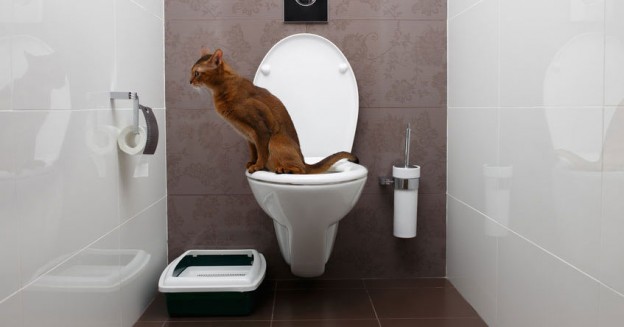Prevent Plumbing Problems: Never Flush Cat Poop Down Your Toilet - Professional Advice
Prevent Plumbing Problems: Never Flush Cat Poop Down Your Toilet - Professional Advice
Blog Article
Here down the page you will find lots of decent details when it comes to How to Dispose of Cat Poop and Litter Without Plastic Bags.

Intro
As cat owners, it's essential to bear in mind exactly how we dispose of our feline pals' waste. While it may appear hassle-free to purge feline poop down the commode, this technique can have harmful effects for both the atmosphere and human wellness.
Environmental Impact
Flushing pet cat poop introduces hazardous pathogens and bloodsuckers into the supply of water, presenting a substantial risk to water environments. These impurities can negatively impact marine life and concession water top quality.
Wellness Risks
Along with environmental issues, purging feline waste can likewise posture health dangers to human beings. Feline feces might include Toxoplasma gondii, a bloodsucker that can cause toxoplasmosis-- a possibly severe illness, specifically for pregnant women and people with damaged body immune systems.
Alternatives to Flushing
The good news is, there are safer and much more accountable ways to take care of pet cat poop. Take into consideration the adhering to alternatives:
1. Scoop and Dispose in Trash
The most typical technique of taking care of pet cat poop is to scoop it right into a naturally degradable bag and toss it in the trash. Make certain to utilize a devoted litter inside story and dispose of the waste without delay.
2. Usage Biodegradable Litter
Choose biodegradable feline clutter made from products such as corn or wheat. These litters are environmentally friendly and can be safely disposed of in the trash.
3. Bury in the Yard
If you have a lawn, take into consideration hiding pet cat waste in a designated area away from vegetable yards and water sources. Make certain to dig deep enough to prevent contamination of groundwater.
4. Mount a Pet Waste Disposal System
Invest in an animal garbage disposal system particularly developed for pet cat waste. These systems utilize enzymes to break down the waste, reducing smell and environmental influence.
Conclusion
Responsible pet ownership prolongs past giving food and sanctuary-- it likewise involves appropriate waste management. By avoiding flushing pet cat poop down the commode and choosing alternate disposal techniques, we can reduce our environmental impact and secure human wellness.
Why Can’t I Flush Cat Poop?
It Spreads a Parasite
Cats are frequently infected with a parasite called toxoplasma gondii. The parasite causes an infection called toxoplasmosis. It is usually harmless to cats. The parasite only uses cat poop as a host for its eggs. Otherwise, the cat’s immune system usually keeps the infection at low enough levels to maintain its own health. But it does not stop the develop of eggs. These eggs are tiny and surprisingly tough. They may survive for a year before they begin to grow. But that’s the problem.
Our wastewater system is not designed to deal with toxoplasmosis eggs. Instead, most eggs will flush from your toilet into sewers and wastewater management plants. After the sewage is treated for many other harmful things in it, it is typically released into local rivers, lakes, or oceans. Here, the toxoplasmosis eggs can find new hosts, including starfish, crabs, otters, and many other wildlife. For many, this is a significant risk to their health. Toxoplasmosis can also end up infecting water sources that are important for agriculture, which means our deer, pigs, and sheep can get infected too.
Is There Risk to Humans?
There can be a risk to human life from flushing cat poop down the toilet. If you do so, the parasites from your cat’s poop can end up in shellfish, game animals, or livestock. If this meat is then served raw or undercooked, the people who eat it can get sick.
In fact, according to the CDC, 40 million people in the United States are infected with toxoplasma gondii. They get it from exposure to infected seafood, or from some kind of cat poop contamination, like drinking from a stream that is contaminated or touching anything that has come into contact with cat poop. That includes just cleaning a cat litter box.
Most people who get infected with these parasites will not develop any symptoms. However, for pregnant women or for those with compromised immune systems, the parasite can cause severe health problems.
How to Handle Cat Poop
The best way to handle cat poop is actually to clean the box more often. The eggs that the parasite sheds will not become active until one to five days after the cat poops. That means that if you clean daily, you’re much less likely to come into direct contact with infectious eggs.
That said, always dispose of cat poop in the garbage and not down the toilet. Wash your hands before and after you clean the litter box, and bring the bag of poop right outside to your garbage bins.
https://trenchlesssolutionsusa.com/why-cant-i-flush-cat-poop/

Do you appreciate more info about Can You Flush Cat Poop Down The Toilet?? Write feedback directly below. We would be glad to listen to your thoughts about this content. We hope to see you back again later on. So long as you enjoyed our blog post kindly don't forget to pass it around. We treasure reading our article about Can You Flush Cat Poo or Litter Down the Toilet?.
This Resource Report this page